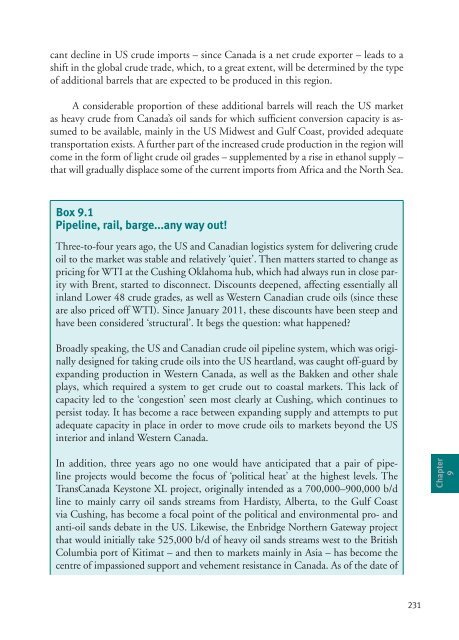World Oil Outlook - Opec
World Oil Outlook - Opec
World Oil Outlook - Opec
- TAGS
- world
- outlook
- opec
- www.opec.org
You also want an ePaper? Increase the reach of your titles
YUMPU automatically turns print PDFs into web optimized ePapers that Google loves.
cant decline in US crude imports – since Canada is a net crude exporter – leads to a<br />
shift in the global crude trade, which, to a great extent, will be determined by the type<br />
of additional barrels that are expected to be produced in this region.<br />
A considerable proportion of these additional barrels will reach the US market<br />
as heavy crude from Canada’s oil sands for which sufficient conversion capacity is assumed<br />
to be available, mainly in the US Midwest and Gulf Coast, provided adequate<br />
transportation exists. A further part of the increased crude production in the region will<br />
come in the form of light crude oil grades – supplemented by a rise in ethanol supply –<br />
that will gradually displace some of the current imports from Africa and the North Sea.<br />
Box 9.1<br />
Pipeline, rail, barge...any way out!<br />
Three-to-four years ago, the US and Canadian logistics system for delivering crude<br />
oil to the market was stable and relatively ‘quiet’. Then matters started to change as<br />
pricing for WTI at the Cushing Oklahoma hub, which had always run in close parity<br />
with Brent, started to disconnect. Discounts deepened, affecting essentially all<br />
inland Lower 48 crude grades, as well as Western Canadian crude oils (since these<br />
are also priced off WTI). Since January 2011, these discounts have been steep and<br />
have been considered ‘structural’. It begs the question: what happened?<br />
Broadly speaking, the US and Canadian crude oil pipeline system, which was originally<br />
designed for taking crude oils into the US heartland, was caught off-guard by<br />
expanding production in Western Canada, as well as the Bakken and other shale<br />
plays, which required a system to get crude out to coastal markets. This lack of<br />
capacity led to the ‘congestion’ seen most clearly at Cushing, which continues to<br />
persist today. It has become a race between expanding supply and attempts to put<br />
adequate capacity in place in order to move crude oils to markets beyond the US<br />
interior and inland Western Canada.<br />
In addition, three years ago no one would have anticipated that a pair of pipeline<br />
projects would become the focus of ‘political heat’ at the highest levels. The<br />
TransCanada Keystone XL project, originally intended as a 700,000–900,000 b/d<br />
line to mainly carry oil sands streams from Hardisty, Alberta, to the Gulf Coast<br />
via Cushing, has become a focal point of the political and environmental pro- and<br />
anti-oil sands debate in the US. Likewise, the Enbridge Northern Gateway project<br />
that would initially take 525,000 b/d of heavy oil sands streams west to the British<br />
Columbia port of Kitimat – and then to markets mainly in Asia – has become the<br />
centre of impassioned support and vehement resistance in Canada. As of the date of<br />
231<br />
Chapter<br />
9
















